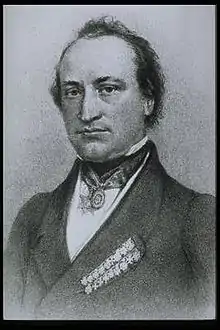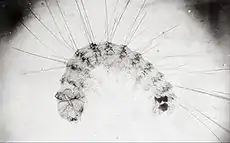Alois Auer
Alois Auer (1813 – 11 June 1869) was a printer, inventor, and botanical illustrator, most active during the 1840s and 1850s. He produced a number of works in German and other languages, including the first regarding the nature printing process. He was the director of the Austrian State Printing House, which created illustrated volumes of scientific interest and produced many advances in printing technology. His name, in the full title of the hereditary knighthood he was given, is Alois Auer Ritter von Welsbach (Knight of Welsbach).
Alois Auer von Welsbach | |
|---|---|
 |
Biography
Born in Wels, Austria, Auer was trained as a compositor, and in his leisure moments studied French, Italian, English, and other languages, in which he underwent an examination in 1835 and 1836 at the University of Vienna. Auer's early career began in October 1837 with an appointment as professor of Italian at a gymnasium in Linz. He acquired fluency in other languages during his travels in Germany, Switzerland, France, and England. That trip began in 1839. He studied the typographical techniques he would use when he became director of the printing office of the Viennese court in 1841. The ornamental typefaces he implemented allowed greater flexibility in printing, and the enterprise was to become highly successful, meeting the requirements of 500 European dialects (exclusive of those Russian, Turkish, and Hebrew), and almost 150 languages of the world. Under his management, the Imperial printing office became one of the largest establishments of the kind in Europe. He remained there until 1868.
The first published work on 'nature printing' (German: Naturselbstdruck), was The Discovery of the Nature Printing-Process (1853).[1] In this he detailed the use of actual plant material, rocks and lace, impressed upon lead or into gum, to demonstrate what he saw as a major advance in the productions of botanical works. His intention was to produce 'artistical-scientific objects', while greatly reducing the problems of producing herbaries and other works of natural history. Another illustrator, Henry Bradbury, began producing work by a similar process after seeing Auer's invention.
The interest in the natural sciences, physics, and languages was met by publications that included his own works. The various printing processes and an extensive history of the Staatsdruckerei, state printing house itself. Apart from the volumes and plates produced by the nature printing process, he also produced some of the earliest books to incorporate photographs. The publication of photomicrography is given to be the first.

He invented a 'typometrical' system, facilitating the use of a large number of foreign alphabets with ornamental type to be used in printing. This was described in his work "Der polygraphische Apparat der Wiener k. k. Hof- und Staatsdruckerei" ("The Polygraphical Apparatus of the Viennese k. k. Court and State Printer").
Auer's directorship at the Royal and State Printing oversaw many advances in automatic high-speed press, copperplate press, and new typographical processes. In Vienna in 1858, Auer patented a web press that printed newspapers from a continuous roll of paper; the press was developed in the United States by William Bullock five years later.[2]
Auer lectured in languages, and later took up the directorship of the Austrian state's porcelain factory.
Family
He was the father of Carl Auer von Welsbach (1858–1929), the Austrian scientist.
Works
Besides the works mentioned above, he produced Die Sprachenhalle oder das Vaterunser in 608 Sprachen (English: The Hall of Languages or the Our Father in 608 languages), with Roman types (1844); and Das Vaterunser in 206 Sprachen (English: The Lord's Prayer in 206 languages), with their national alphabets (1847).
See also
References
- Vienna: K.K Hof- und Staatsdruckerei, 1853. 4 volumes, printed paper wrappers; Italian, French, English, German.
- Consuegra, David, American Type Design and Designers. New York: Allworth Press (Skyhorse Publishing, Inc.) ISBN 1-58115-320-1, 2004, page 19
- Transcription of article from the 'Universal German Biography' by Karl Karmarsch (German language). Artikel "Auer, Alois“ aus: Allgemeine Deutsche Biographie, herausgegeben von der Historischen Kommission bei der Bayrischen Akademie der Wissenschaften, Band 1, ab Seite 637, Digitale Volltext-Ausgabe in Wikisource, URL: http://de.wikisource.org/w/index.php?title=ADB:Auer%2C_Alois&oldid=124946 (Version vom 2. September 2007, 02:01 Uhr UTC)
- "Plants and gardens portrayed". Onlinexhibits. LuEsther T. Mertz Library of The New York Botanical Garden. Archived from the original on 31 August 2007. Retrieved 1 September 2007.
Alois Auer invented techniques of "nature printing" at the Imperial Printing Office of Austria
- "Sale of works by author". zuckerartbooks.com. Archived from the original on 16 December 2012. Retrieved 1 September 2007.
Indeed, this must be one of the earliest published microphotographs. Also, in light of the famous controversy between Auer and Bradbury over the invention of nature printing, ...
- "Auer von Welsbach, Alois Ritter". aeiou. Encyclopedia of Austria. Retrieved 2 September 2007.
[Short bio and picture]
- German text article http://www.zeno.org/Schmidt-1902/K/schmid-1902-001-0014.png
- Rines, George Edwin, ed. (1920). . Encyclopedia Americana.
- Gilman, D. C.; Peck, H. T.; Colby, F. M., eds. (1905). . New International Encyclopedia (1st ed.). New York: Dodd, Mead.
